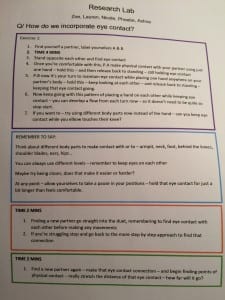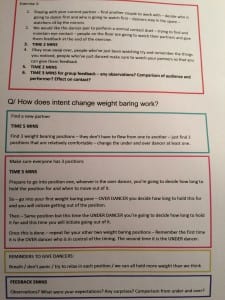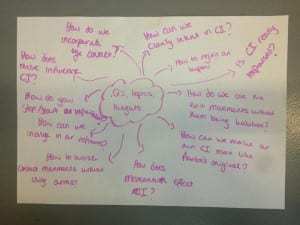Going Up!
“The further your center is above your base of support, the less stable you are” – (Woodhull, 1978, 47)
Ow! That’s my summary of this week: ow ow ow ow OW! I did not think that practicing just a few little lifts could cause so much muscular pain, but my god was I wrong; I even have bruises, although one is from where I landed on my own hand, so who’s really to blame for that one? Going up was never going to be my favourite week as I don’t respond well to being lifted. Even if I know the person is capable, I can’t keep my ‘s***’ together and start making involuntary sequels and tensing up, thus making myself heavier. But actually, this week wasn’t as awkward/intimidating as I thought it was going to be, and I think that had a lot to do with the caring nature of everyone in our class. We’re all really supportive of each other and genuinely want each other to do well and feel confidant with the tasks, which made me feel a lot better at taking a while to get to grips with certain lifts/balances. For example, the table top balances, and the stretched legs on partners hips lift were two that I particularly struggled with and could have easily given up on, but the people around me, and my partner Yasmin were really supportive and helpful which motivated me to keep going.
I was nervous to try pretty much all of the lifts that we were introduced to, but having read Ann Woodhull’s article Center of Gravity I knew that as long as my center of gravity (c.o.g) was “over the point of contact” in the lift (Woodhull, 1978, 44) I wouldn’t fall and my partner would have a better chance of sustaining the position. I also learnt the importance of locking my legs and arms in certain positions, as otherwise I couldn’t hold my own or my partners weight, because gravity would pull me off balance – probably because my ‘c.o.g’ wasn’t ‘centered’, a moment that Woodhull explains as when “the body tends to turn and fall on the side where the center of gravity is” (Woodhull, 1978, 44). Without establishing the connection from my ‘c.o.g’ to my partners, every lift would have been much harder and would have caused much more physical exhaustion. Now that I’ve experienced this side of CI, I’m more positive about including lifts in my choreographed duet; I’m excited to see what positions Sophie and I can create now that I’m going into it with much less hesitation.
By Thursday evening my body was in so much pain that I decided to avoid contacting with anyone in the jam, and would use the time to focus on my own improvisation. After having a tutorial with Kirsty, I wanted to experiment with using my whole body in my movements, so that they could be described as fluid and connected, not arm and leg actions. It was quite hard to do this because at first I wasn’t using my breath – I was trying to connect my waist to my shoulders to my wrists to my neck etc without using breath as the initiation and so struggled to find fluidity in the movements. But once I stepped out of the improvisation and watched everyone else, the penny dropped and I realised that dynamics are not just how fast/slow you move; having qualities like sharpness, elongation, softness and directness (to name a few) also effect the dynamics of an action. Once I started pairing my breath to my movements I found a whole new level of enjoyment with my dancing, and I hope that if I keep working on this relationship I can make significant progress with my own improvisations.
I need to be brave when it comes to partner work – so often I’ll talk myself out of trying an idea because there are too many potential outcomes that are not success. If I find myself in the middle of a group of bodies, why not just pick one of them up? Why not manipulate their movements so that they have to give weight to me? Why not just grab one of them and run away into some open space and start jamming together? Because I’m scared, that’s why. I’m scared that I’ll start jamming with someone and they’ll make a move to pick me up but I’m not very good at being the lifted so I’ll have to awkwardly roll away from them. I’m scared that I’ll be in a balance position as the over dancer and go to get out of it by going upside down and kick someone in the face/fall and hurt myself. I’m scared of failing – which unsettles me a lot because you have to fail to succeed, so it’s easier to stick to what you know and rely on yourself. But I don’t want to keep doing this, so I’m going to try and throw myself into the unknown over the next few weeks. If I don’t challenge myself now I won’t know how far I can be pushed and I’ll regret it.
Woodhull, A. (1978) Center of Gravity. Contact Quarterly/Contact Improvisation Sourcebook. 4(1) 43-48.


